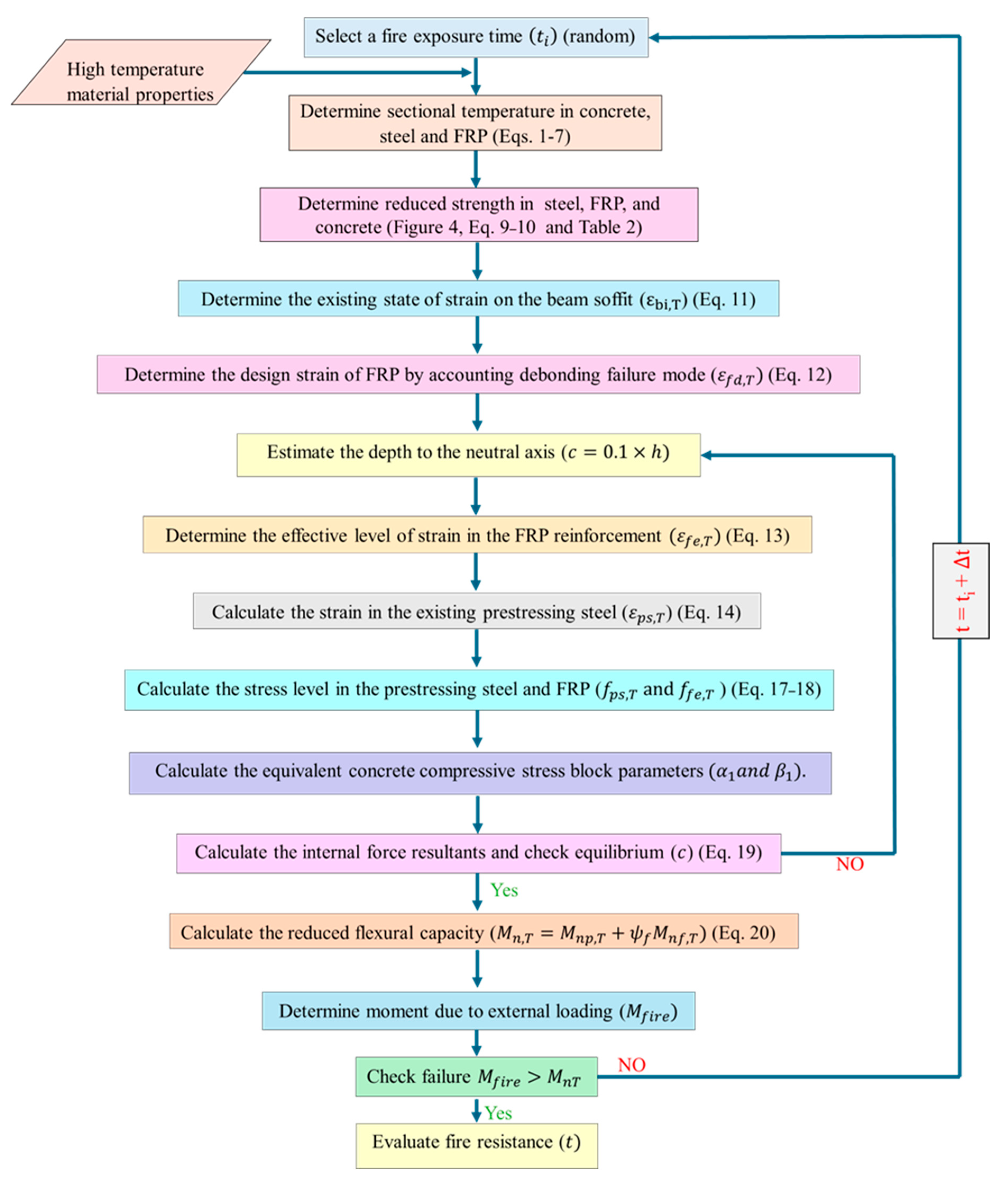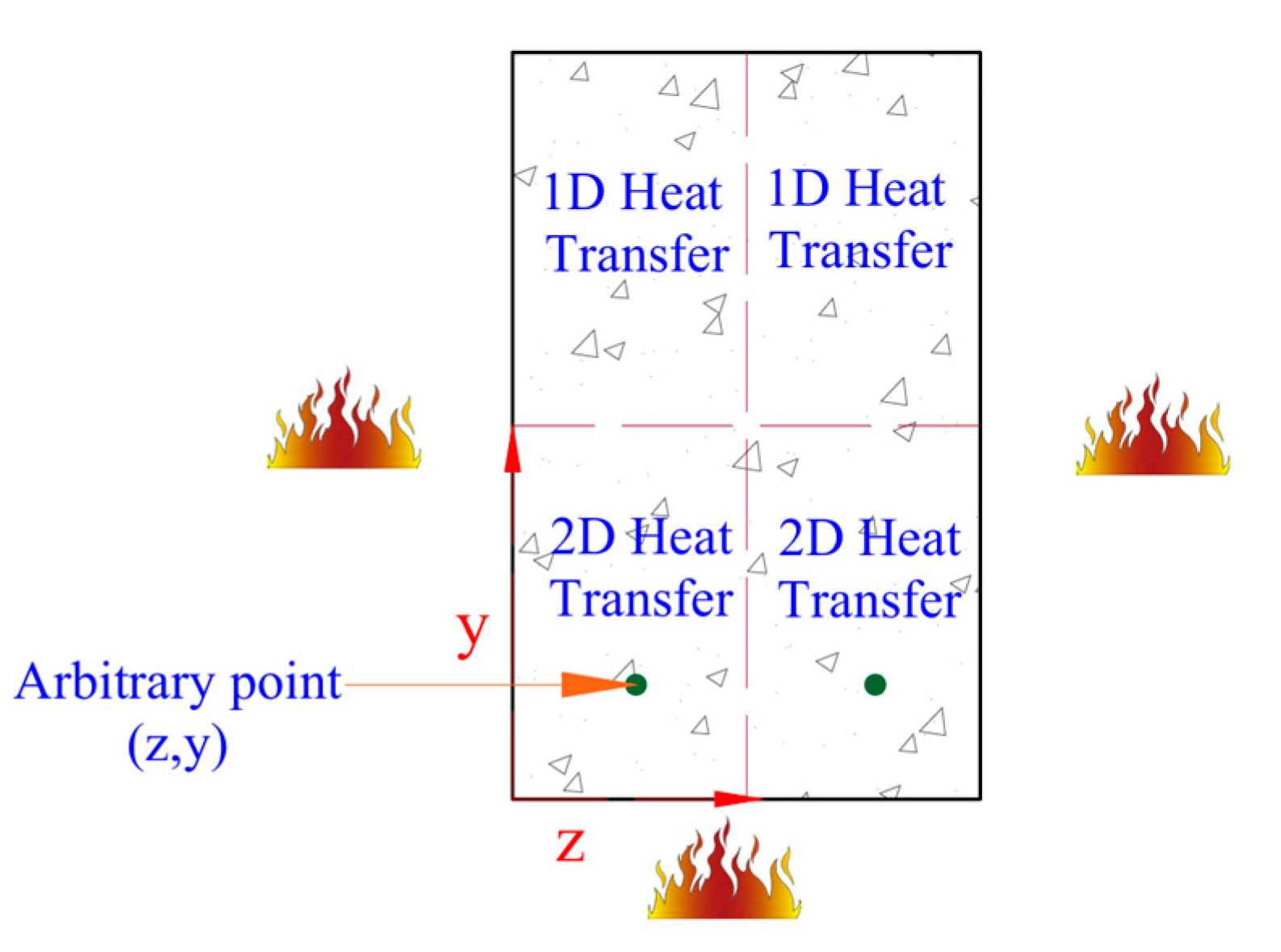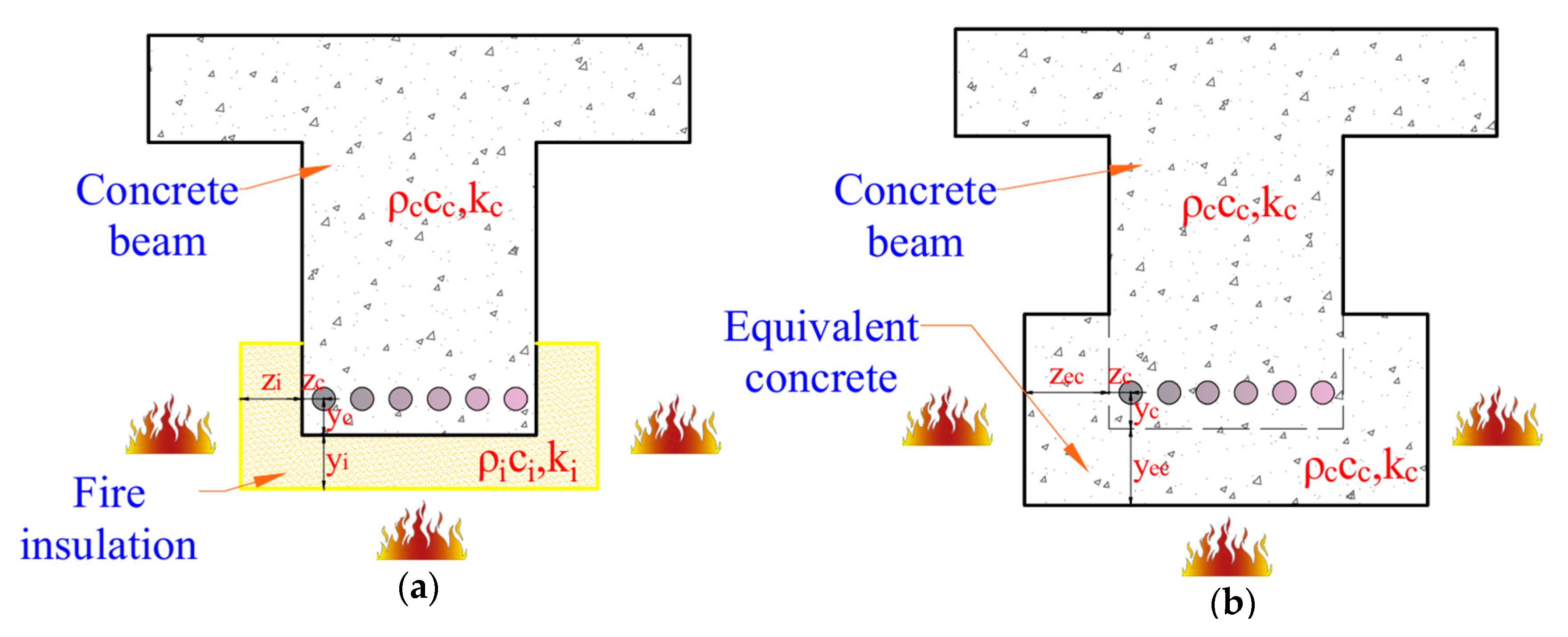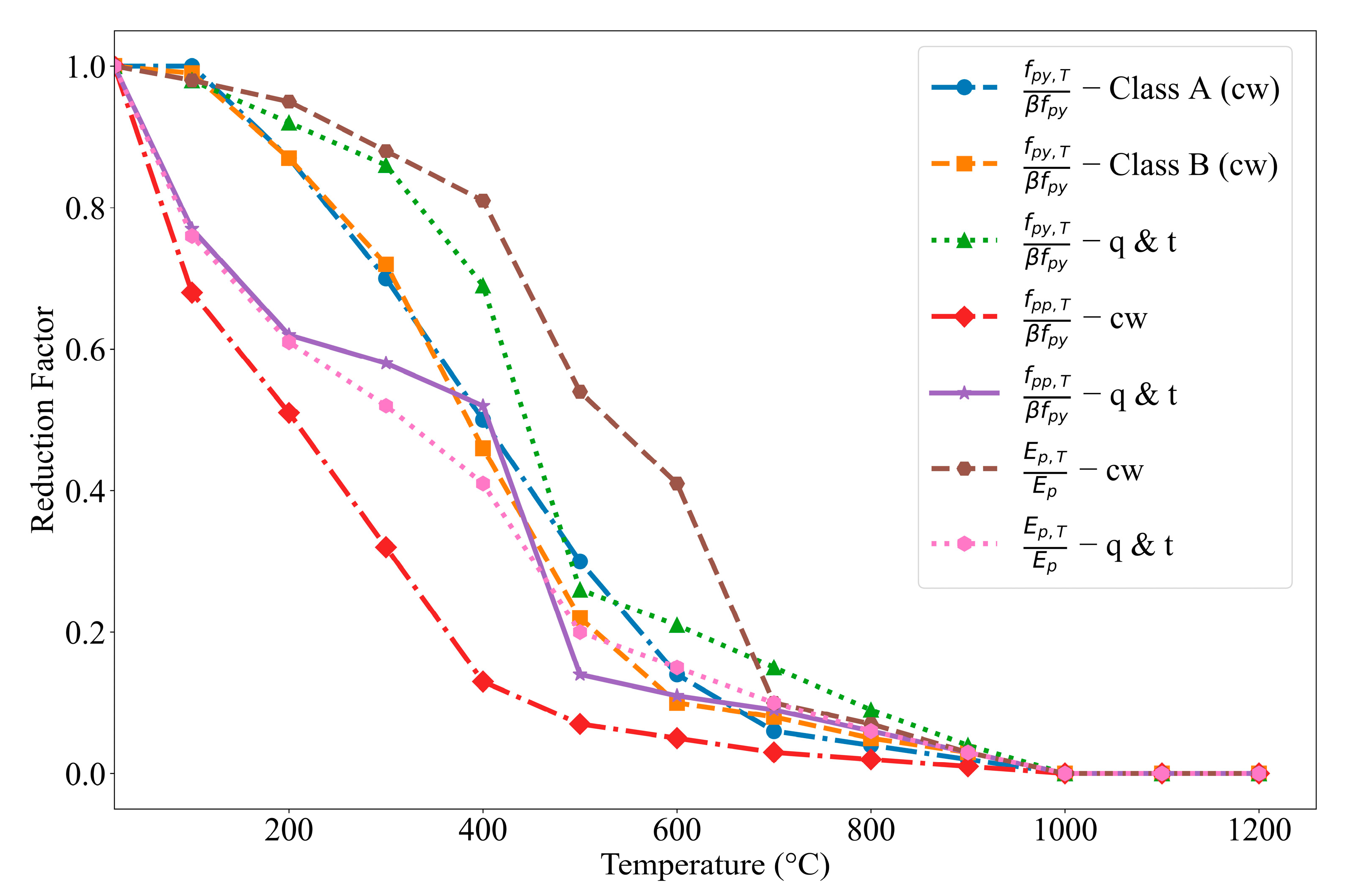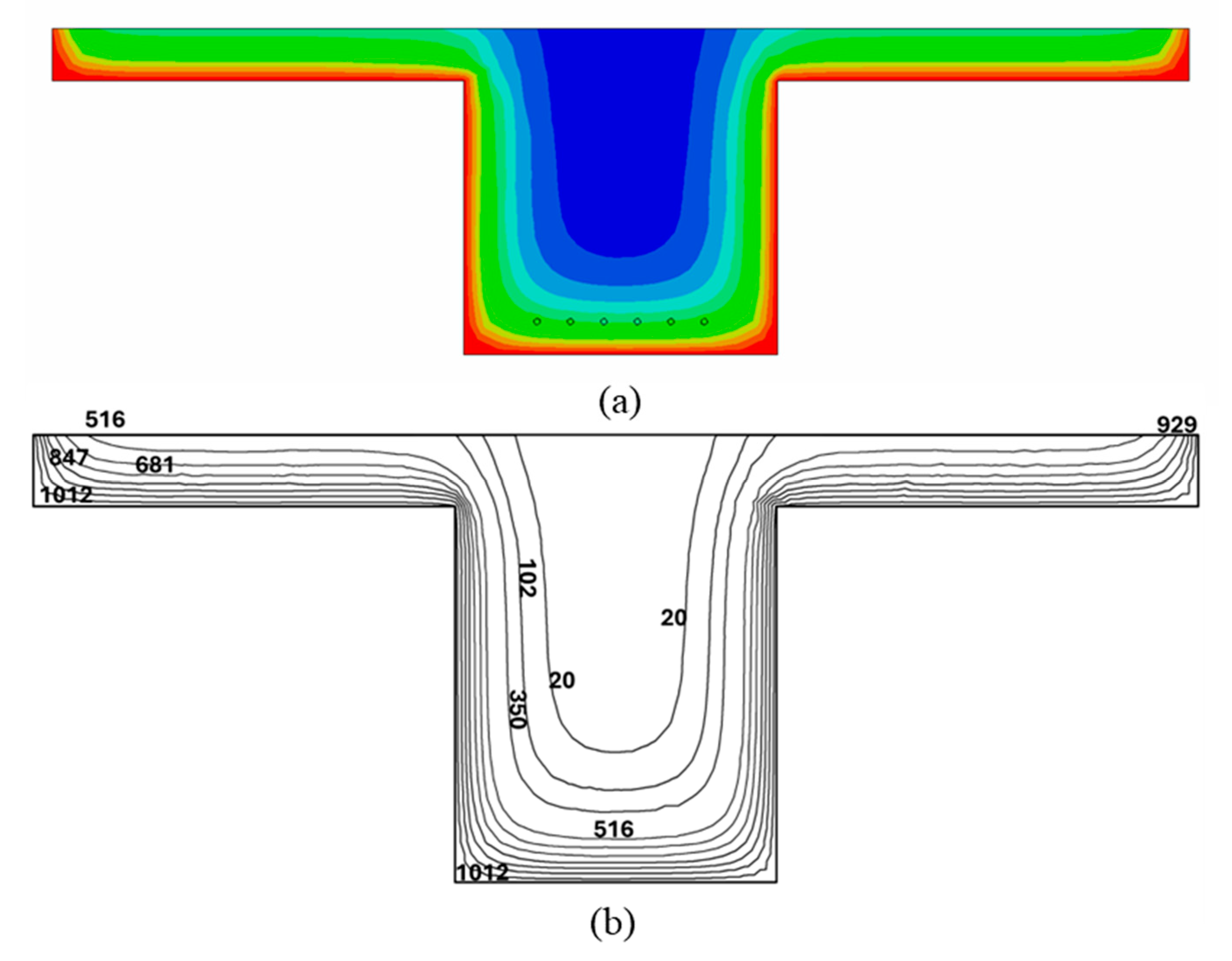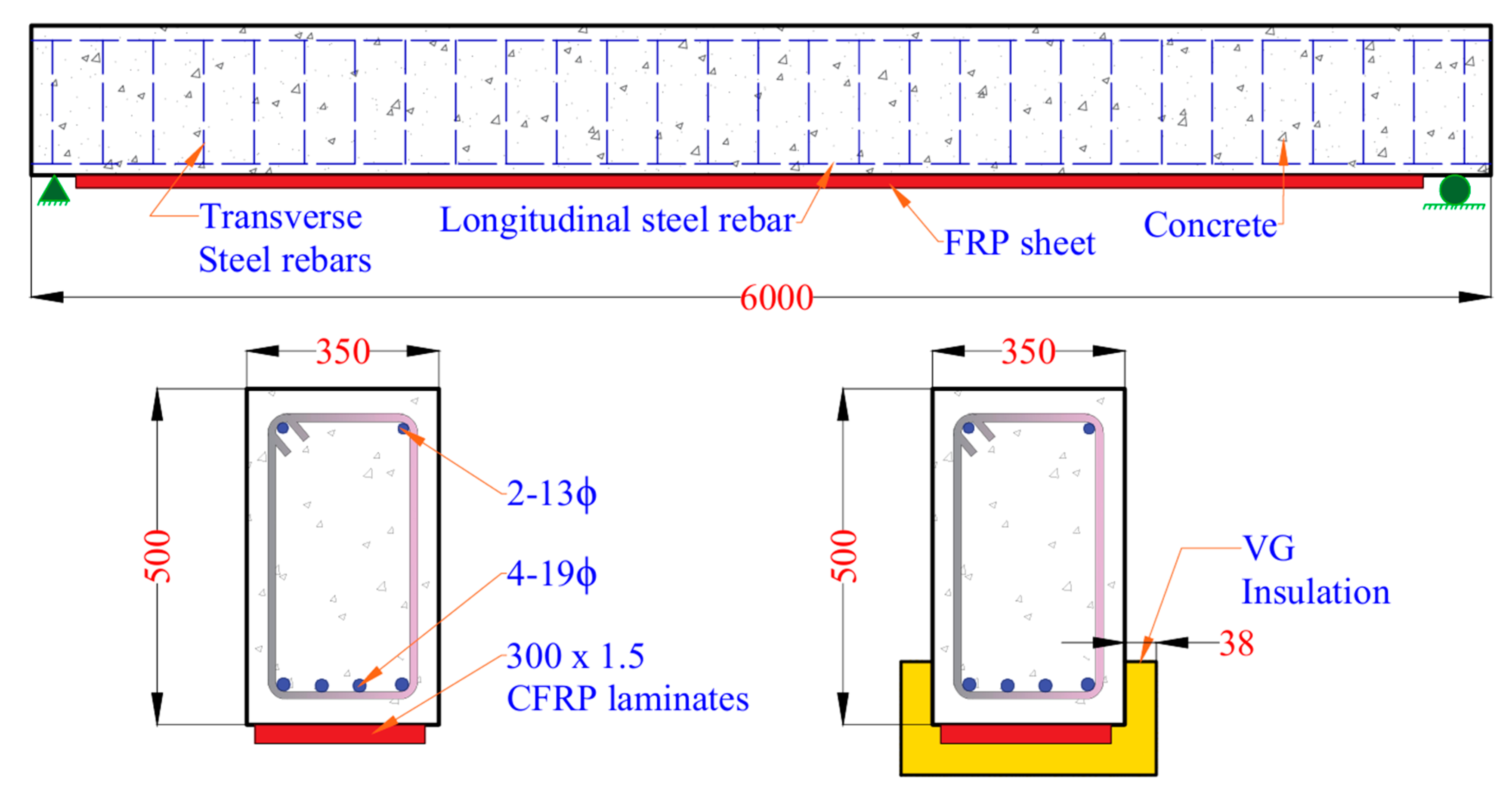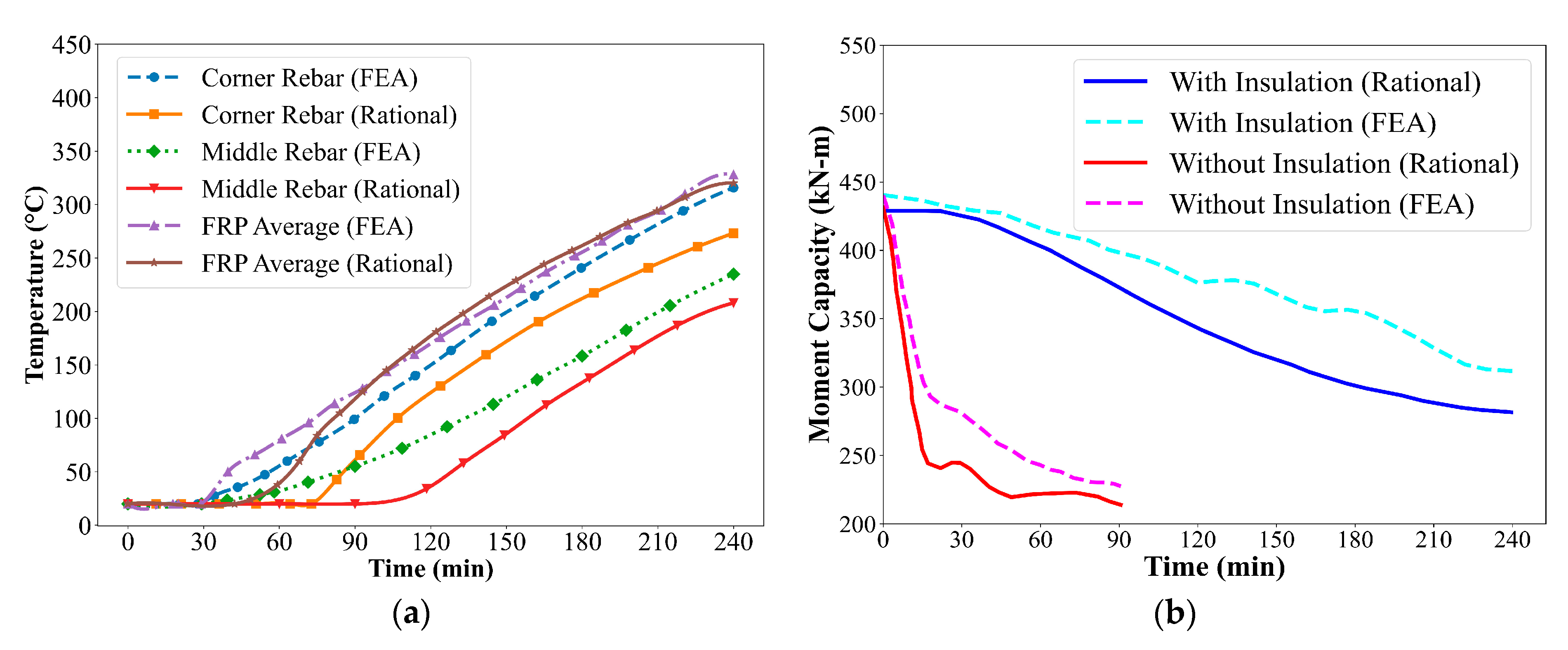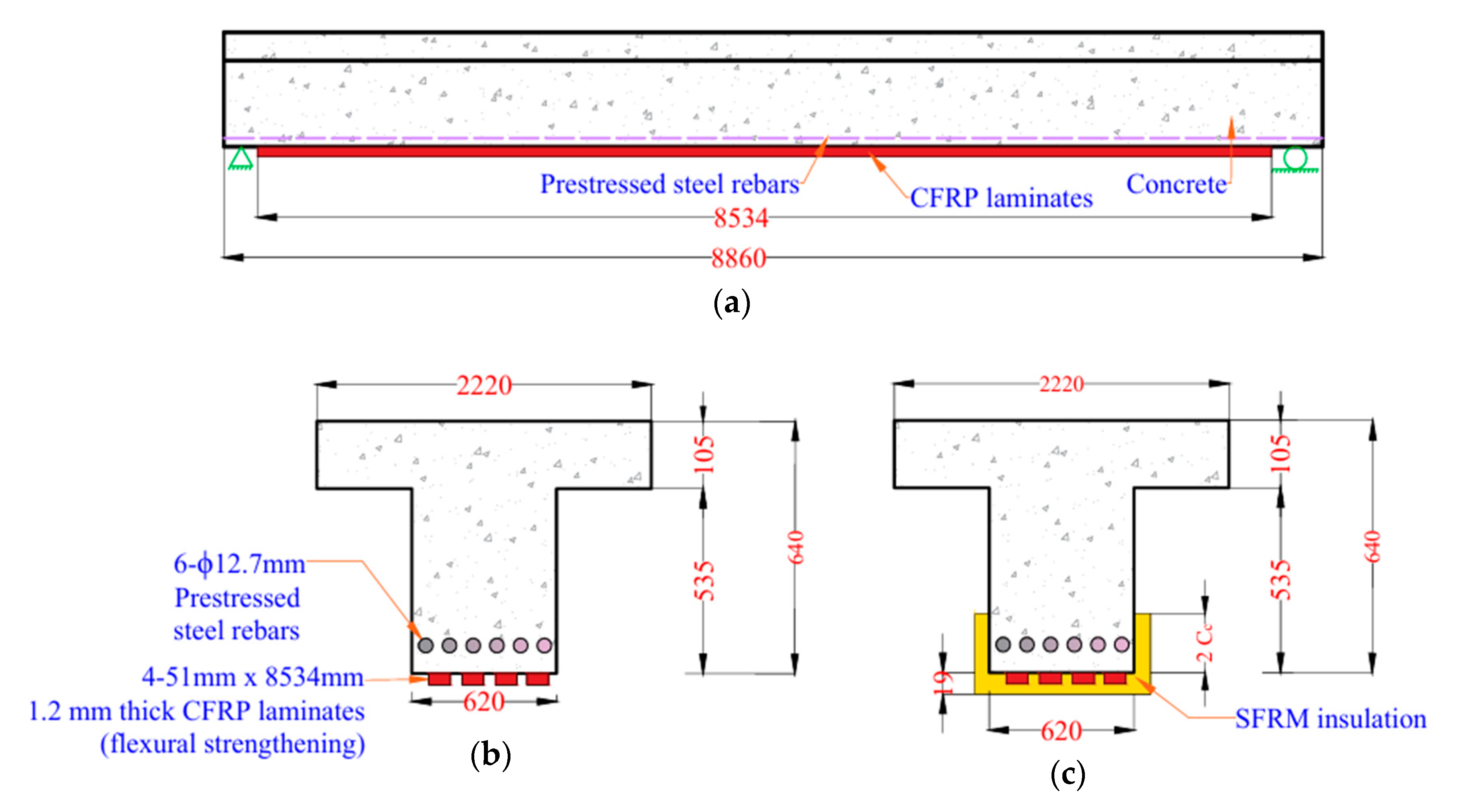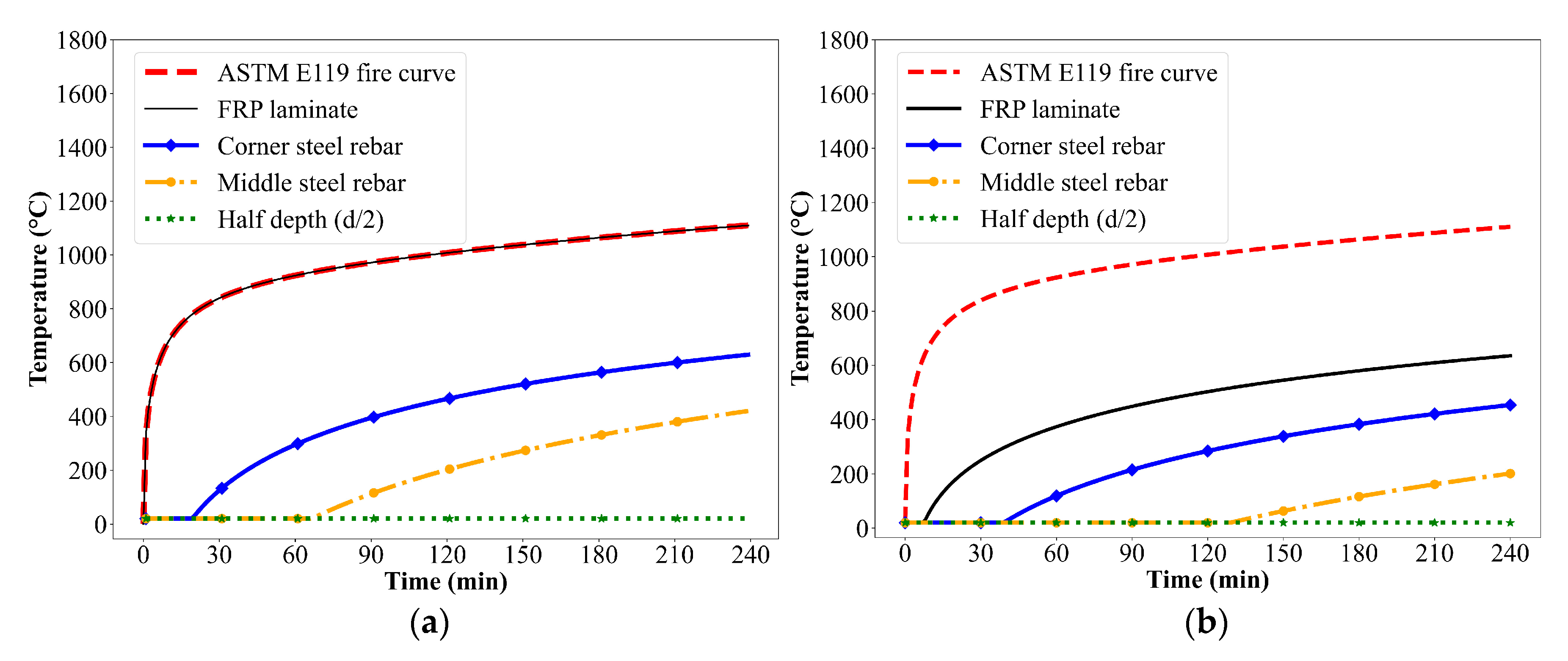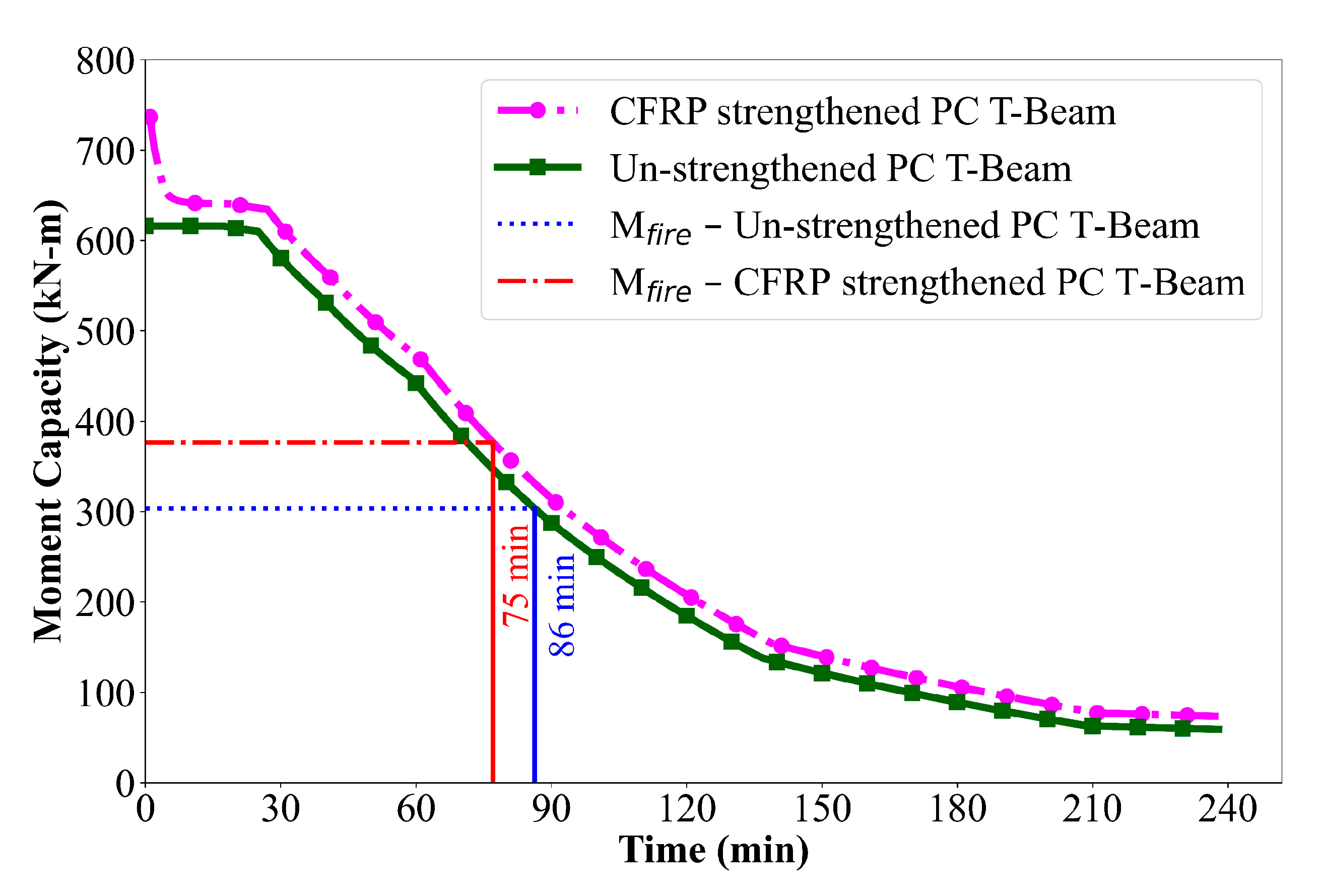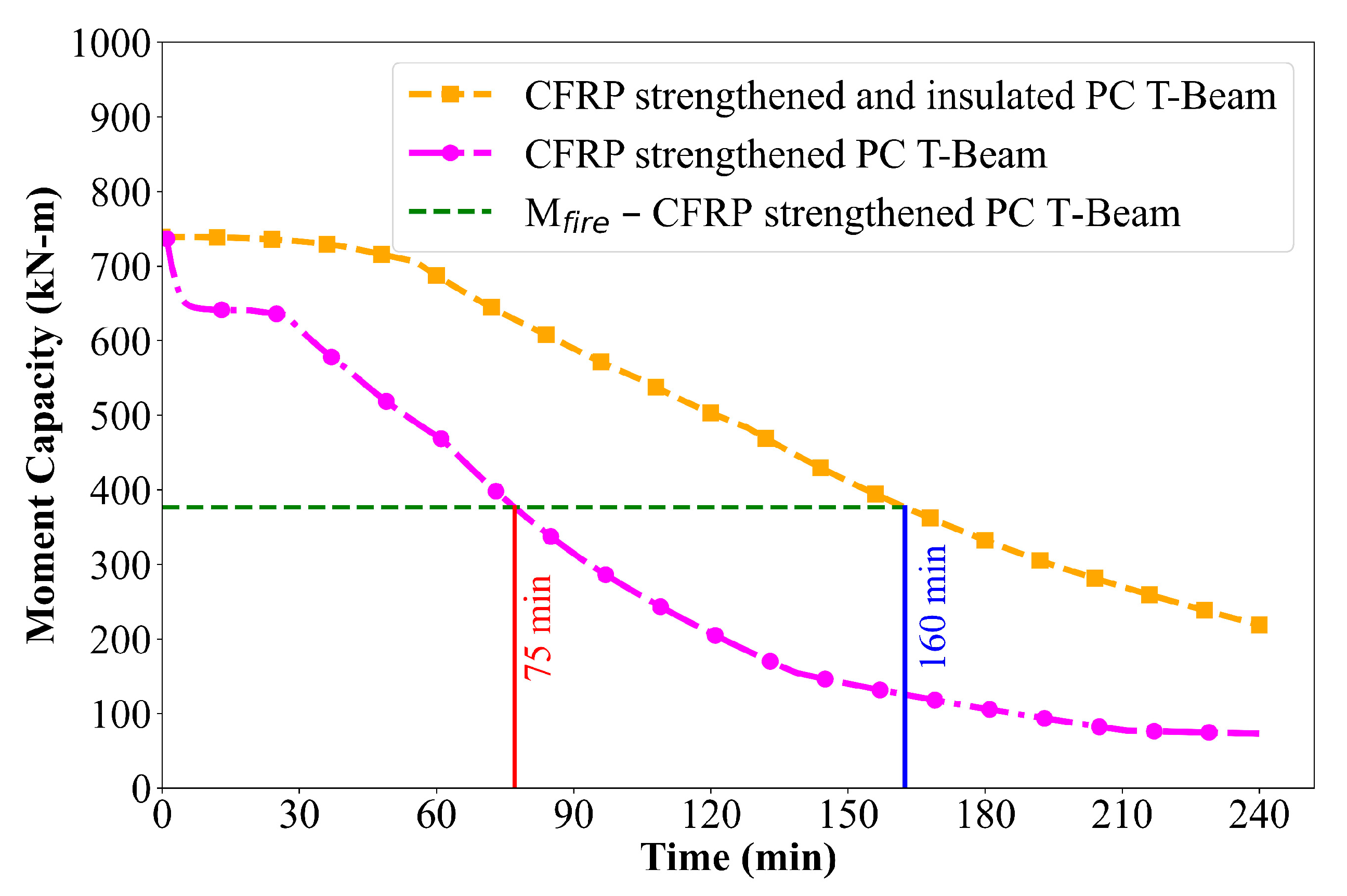1. Introduction
Prestressed concrete (PC) structures are widely used in modern construction due to their durability and ability to span longer distances with reduced cross-sectional dimensions. However, over time, these structures experience strength degradation caused by factors such as loss of prestress, poor maintenance, corrosion of prestressing steel strands, concrete aging, and exposure to aggressive environmental conditions. Additionally, increased loading demands, changes in building use, changes in occupancy type, design deficiencies, and updated building codes necessitate retrofitting and strengthening of the structure to ensure continued safety and performance. Traditional strengthening methods for PC structures include enlarging concrete sections, applying steel jackets, bonding steel plates, and using external post-tensioning with steel tendons [
1]. Although effective, these techniques add significant weight, alter structural geometry, and are prone to corrosion, resulting in higher maintenance costs and complex installation processes. In contrast, fiber-reinforced polymers (FRPs) have emerged as a popular alternative for strengthening PC structures due to their high strength-to-weight ratio, excellent corrosion resistance, ease of application, and minimal impact on the structure’s appearance and weight.
Extensive research has been conducted on the mechanical performance of FRP-strengthened PC structures at ambient temperature, with various studies demonstrating significant improvements in structural capacity. The strengthening of prestressed bridge slabs was experimentally investigated using five FRP systems, including near-surface mounted (NSM) bars and externally bonded (EB) carbon fiber-reinforced polymers (CFRP) [
2]. The study found that CFRP reinforcement strengthening enhanced stiffness and increased ultimate load capacity of slabs by up to 50%. Similarly, an experimental investigation on the static loading behavior of prestressed concrete bridge girders revealed that CFRP strengthening improved flexural capacity by up to 73% while maintaining ductility [
3,
4]. Additionally, the findings indicated that CFRP significantly reduced crack spacing and widths, with crack widths decreasing by up to 10% compared to un-strengthened girders. Subsequently, five full-scale PC girders with varying levels of tendon damage and CFRP strengthening were experimentally tested [
5]. The study found that 17% and 33% strand loss led to 20% and 26% reductions in flexural capacity, respectively. CFRP laminates with U-wrap anchorage restored up to 16% of capacity but resulted in brittle failure. Furthermore, an experimental study on the strengthening of 60-year-old PC bridge deck units using adhesively bonded CFRP plates demonstrated a 10% increase in load-carrying capacity at the serviceability limit and a 54% improvement in ultimate strength [
6].
Despite the numerous advantages of FRP composites, they exhibit significant performance limitations when exposed to elevated temperatures, making fire resistance a major concern in structural applications [
7,
8,
9]. The primary limitation arises from the polymer matrix, which is highly susceptible to thermal degradation. As temperatures approach the glass transition temperature (
), typically from 65 °C to 100 °C, the polymer matrix softens, reducing its ability to transfer shear stress between fibers and leading to a decline in FRP mechanical properties such as tensile strength and stiffness [
10,
11]. Further exposure to temperatures from 300 °C to 500 °C causes the decomposition of the resin, releasing heat, smoke, soot, and harmful volatiles, which not only exacerbates the degradation of mechanical properties but also poses environmental and safety concerns [
12]. At these temperatures, chemical bonds within the polymer structure break down, leading to fiber–matrix debonding and structural failure [
13]. Consequently, the lack of inherent fire resistance in FRP materials necessitates additional protective measures when used in load-bearing structural applications, as their failure can occur early into fire exposure if not adequately insulated, specifically in externally bonded FRP systems [
14].
To address the fire-induced vulnerabilities of FRP-strengthened structural members, extensive research has been conducted to evaluate their behavior under elevated temperature exposure and to develop strategies to enhance their fire resistance. Experimental studies demonstrated that CFRP-strengthened rectangular RC beams with 25 mm spray-applied Tyfo
® WR can withstand failure under design fire conditions, including three hours of ASTM E119 growth phase followed by a decay (cooling) phase [
15]. Additionally, experimental and numerical investigations on CFRP-strengthened RC beams evaluated the effectiveness of calcium silicate(CS) boards and vermiculite/perlite (VP) mortar as fire protection [
16,
17]. The findings revealed that unprotected CFRP debonded from RC beams after 23 min, whereas 25 mm and 40 mm insulation extended failure times to 60–89 min and 137–167 min, respectively, with VP mortar proving more effective than CS boards in reducing temperatures at the CFRP–concrete interface. Likewise, experimental and numerical studies demonstrated that CFRP-strengthened RC T-beams with 19 mm and 32 mm spray-applied fireproofing on the bottom and sides sustained service load levels for up to four hours under ASTM E119 fire exposure [
18].
Despite these advancements, experimental and numerical studies on the fire resistance of FRP-strengthened beams remain complex, time-consuming, and require advanced modeling techniques. To address this limitation, a rational design method was proposed that incorporates the contribution of FRP, the effects of fire insulation, and temperature-dependent material degradation into fire resistance calculations [
19]. Furthermore, the accuracy of this approach has been validated through comparisons with fire test data and finite element analysis (FEA) results, demonstrating a margin of error within 10%, confirming its applicability and reliability for structural fire design. Following this development, a detailed review was presented on the fire performance of FRP-incorporated concrete structures, with particular focus on the thermal, mechanical, bond, and combustibility properties of FRP materials at both room and elevated temperatures [
10]. The review incorporates findings from experimental studies, numerical simulations, and existing code provisions to provide a comprehensive overview of the current understanding of fire behavior in FRP-strengthened members. Based on these studies, it is evident that while fire resistance ratings of up to four hours can be achieved with appropriate fire protection, current design practices do not adequately account for the degradation of FRP properties at elevated temperatures. The findings also highlight the importance of developing rational fire design approaches that accurately reflect the behavior of FRP systems under fire exposure.
The fire resistance of FRP-strengthened RC beams has been extensively studied over the past few decades, with numerous studies focusing on their structural behavior under elevated temperatures. However, there is a noticeable lack of research specifically addressing FRP-strengthened PC beams, as most existing studies have focused primarily on their performance under ambient conditions without considering the impact of fire. There is a significant difference in the degradation of mechanical properties of prestressing steel compared to conventional reinforcing steel bars under elevated temperature exposure. Prestressing steel, due to its composition, tends to lose strength more quickly, which can cause earlier and more severe failure. Experimental studies have reported that the ultimate and yield strength of low-relaxation seven-wire prestressing strands degrade more rapidly than reinforcing steel bars over the 20–800 °C temperature range [
20]. Additionally, a strength reduction of approximately 50% was observed around 450 °C. Since both FRP materials and prestressing tendons experience substantial degradation at elevated temperatures, further investigation is essential to understand their combined effect on structural behavior, failure mechanisms, and potential fire protection strategies.
This paper addresses the existing knowledge gap by extending the rational approach, previously developed for FRP-strengthened RC beams, to evaluate the fire resistance of CFRP-strengthened PC beams. The methodology is first validated against available experimental and numerical data on FRP-strengthened RC beams and subsequently applied to PC beams to quantify their fire performance. A comprehensive parametric study is conducted to evaluate the effects of insulation thickness, concrete cover depth, and strengthening configuration on the fire resistance of CFRP-strengthened PC beams, and the resulting findings, methodological limitations, and design implications are presented to guide their safe application in fire-prone environment.
2. Rational Approach for Evaluating Structural Behavior Under Fire Conditions
A systematic approach for evaluating the fire resistance of FRP-strengthened PC beams is developed in this paper, based on established fire design principles for conventional PC beams, incorporating the influence of FRP reinforcement and fire insulation in fire resistance evaluation. This approach consists of two fundamental steps: (1) analyzing the temperature distribution resulting from fire exposure within the concrete, FRP, and prestressing tendons of the strengthened PC beam, and (2) computing the reduced moment capacity at the critical cross-section for varying durations of fire exposure, with due consideration to temperature induced degradation in strength properties of all constituent materials.
The flowchart in
Figure 1 illustrates the step-by-step procedure for evaluating the fire resistance of an FRP-strengthened PC beam. The evaluation process involves iterative calculations conducted at various time increments until failure occurs under fire exposure. Failure is defined as the time step at which the moment capacity at the critical section falls below the applied moment due to loading. The total time elapsed until this failure step is recorded as the fire resistance of the beam. Smaller time increments, such as one minute, are recommended to improve the accuracy of failure prediction, since CFRP and prestressing steel undergo rapid strength and stiffness degradation once critical temperatures are reached.
The first step in the analysis involves determining temperature distributions within the FRP, prestressing steel, and concrete for a specified fire exposure duration using simplified equations, accounting for both insulated and uninsulated FRP-strengthened PC beams. Based on the sectional temperatures, the resulting degradation in material properties, including reductions in strength and stiffness, is determined. The strain in both the FRP and prestressing steel is then assessed while considering the effects of potential debonding failure and rupture. Corresponding stresses are computed using the reduced strength and modulus properties of the FRP and prestressing steel.
The concrete compressive stress block parameters are subsequently calculated to establish equilibrium within the section. Once the force equilibrium is attained, the reduced flexural capacity of the FRP-strengthened PC beam is determined by incorporating the strength contributions of the prestressing tendons, FRP reinforcement and concrete. The final step involves comparing the reduced moment capacity with the applied moment demand under fire conditions, with the final time at which failure occurs being deemed as the fire resistance of the beam.
3. Analysis of Cross-Sectional Temperatures
The fire resistance of FRP-strengthened PC beam is significantly affected by the degradation of strength in the FRP reinforcement, prestressing steel, and concrete due to elevated temperatures. Therefore, accurate prediction of cross-sectional temperature distribution at various fire exposure durations is essential for evaluating the structural response of the beam under fire conditions. For an uninsulated FRP-strengthened PC beam, the temperature distribution across the cross-section remains nearly the same as that of an un-strengthened PC beam. This is because externally bonded FRP reinforcement has a relatively much smaller cross-sectional area compared to concrete, resulting in a minor impact on heat transfer within the beam. A set of simplified equations was developed to estimate cross-sectional temperatures in RC members exposed to standard fire conditions [
21]. These equations have been validated through FEA results and fire test data, demonstrating accuracy within a ±10% margin, particularly for temperatures in the range of 300–700 °C. Since PC and RC beams exhibit similar thermal responses, the same temperature prediction equations are applied in this study for FRP-strengthened PC beams.
The temperature (
at any point within the cross-section of a concrete beam, represented by coordinates y and z in
Figure 2, can be determined for a specified fire exposure duration using this method and the below equations.
For one-dimensional heat transfer, we use
For two-dimensional (2D) heat transfer, we use
where
The parameter
represents duration of fire exposure in hours,
and
indicate the distance from a given point within the concrete section to the fire-exposed surface (m), and
represents the fire temperature according to ISO 834 or ASTM E119 standard fire conditions. The coefficients
,
,
, and
used in the temperature prediction equations are taken from
Table 1. Equations (1)–(4) are applicable for estimating cross-sectional temperatures in FRP-strengthened PC beams without fire insulation.
For an FRP-strengthened PC beams with fire insulation, the temperatures in concrete, prestressing steel, and FRP reinforcement are significantly reduced due to the protective insulating effect of the fire insulation layer. In these insulated beams, thermal behavior is primarily influenced by the properties of both insulation and concrete. The temperature distribution within an insulated PC section can be determined using the same equations [Equations (1) and (2)] applied to uninsulated PC beams, by converting the insulation layer into an equivalent concrete layer to account for its thermal resistance. Since fire insulation materials commonly used in protection possess much lower thermal conductivity and higher specific heat capacity than concrete, the insulated region experiences a significant reduction in heat transfer. To account for this in thermal analysis, the insulation layer is transformed into an equivalent concrete layer that provides the same thermal resistance. Due to the effective insulating properties, the resulting equivalent concrete section becomes significantly enlarged to match the resistance, as illustrated in
Figure 3b.
A U-shaped fire layer is applied to a PC beam, as shown in
Figure 3a, with insulation thicknesses
on the sides and
on the bottom. When the insulation layer is substituted with an equivalent concrete layer of thickness
on the sides and
on the bottom, as illustrated in
Figure 3b, the temperature distribution within the beam’s cross-section should remain unchanged. By applying fundamental heat transfer principles and one-dimensional heat transfer equation [Equation (1)], the relationship between the fire insulation thickness and the corresponding equivalent concrete thickness can be derived [
21]:
where
and
are regression coefficients, while
and
are thermal conductivity and heat capacity of concrete and insulation, respectively.
Through nonlinear regression analysis of a comprehensive dataset generated using FEA, the regression coefficients α and β were determined as 4.5 and 1.75, respectively [
22]. The accuracy of these coefficients, obtained from regression analysis, falls within a 5–15% range, depending on the sectional dimensions of the beam and concrete properties. By applying the equivalent concrete depth method, the distance from the outer edge of the insulation to the fire-exposed surface (
and
can be determined using the following equations.
These equivalent concrete depths ( and ) can be substituted into Equations (1)–(4) by replacing and to evaluate the cross-sectional temperature rise in an insulated PC member.
4. Degradation of Material Properties
Knowing the cross-sectional temperatures within a PC beam, the impact of temperature on the strength degradation of concrete, prestressing steel, and FRP can be determined. Prestressing steel undergoes a more rapid reduction in strength and modules compared to conventional steel reinforcement, making it particularly vulnerable to fire exposure. Various models have been developed to characterize the temperature-dependent behavior of prestressing steel, with well-established relationships available for predicting strength and elastic modulus degradation. In this study, the temperature-strength and stiffness relationships specified in Eurocode 2 [
23] (
Figure 4) are adopted to evaluate the strength and modulus reductions in prestressing steel at different temperature levels.
In
Figure 4,
refers to cold-worked (wires and strands),
refers to quenched and tempered (bars), and
is a factor calculated based on Equation (8). The parameters
and
are material properties at room temperature as per Eurocode 2 [
23].
Extensive research on externally bonded FRP laminates has demonstrated that FRP reinforcement undergoes significantly higher strength and stiffness degradation than reinforcing steel upon reaching its glass transition temperature (
). Through experimental and modeling studies, researchers have developed empirical relationships to quantify the reduction in strength and modules for different FRP types at elevated temperatures. The strength and modulus reduction relationships [Equations (9) and (10)] for externally bonded CFRP laminates at elevated temperatures, developed in previous studies, are currently utilized in evaluating fire resistance [
14]. Similar relationships for other types of FRP, such as AFRP and GFRP, can be found in related research [
19].
Strength reduction factor:
Elastic modulus reduction factor:
Concrete generally exhibits good performance at elevated temperatures due to its low thermal conductivity and high heat capacity, which slows down heat penetration and delay strength loss. Unlike steel reinforcement, concrete retains a significant portion of its mechanical properties under fire exposure, especially in its inner core, where temperatures rise more gradually. However, longer exposure to high temperatures leads to progressive strength degradation, particularly in the outer layers of concrete elements. To account for strength degradation due to temperature exposure, Eurocode 2 [
23] introduces the effective concrete width approach. This method takes into account the contribution of concrete in the portion of the compression zone width where the temperature remains below 500 °C, while the strength contribution of concrete in the outer concrete layers exceeding 500 °C is neglected.
However, Eurocode 2 [
23] does not specify values for effective width reduction in PC T-beams, resulting in a lack of predefined reduction factors for these elements. Although simplified cross-sectional temperature equations [Equations (1)–(4)] are available, they were not used in this study because they provide temperature values only at specific points within the section, making it difficult to construct a complete temperature gradient curve throughout the cross-section of the beam. To achieve better accuracy, a finite element analysis (FEA) using ABAQUS was conducted to evaluate the thermal response of the PC beam cross-section at specified fire exposure durations, following the simulation process demonstrated in previous research [
24]. The temperature-dependent thermal properties of concrete, such as thermal conductivity and specific heat, were adopted from Eurocode 2 [
23]. The temperature gradient curves shown in
Figure 5b were analyzed across the cross-section, and the outer layer elements in the upper half of the beam within the compression zone, where temperatures exceeded 500 °C, were excluded from the total beam width. The effective reduction factors were then calculated and presented in
Table 2.
5. Determining Moment Capacity at a Specified Fire Exposure Duration
Knowing the temperature-induced degradation of material properties, including the yield stress
, ultimate stress
and Young’s modulus
of prestressing steel, along with the ultimate stress
and Young’s modulus
of FRP reinforcement and
of concrete, the flexural capacity of FRP-strengthened PC beams at a specific fire exposure time can be determined by using a methodology similar to that used for room-temperature conditions, as outlined in ACI 440.2R-17 [
8] and ACI [
25]. According to ACI 440.2R-17, failure in an FRP-strengthened beam section at ambient temperature can occur through multiple mechanisms. These include concrete crushing in compression before the prestressing steel reaches its yield strength, yielding of the steel in tension followed by rupture of the FRP laminate, and yielding of the steel in tension leading to concrete crushing. Additionally, failure under fire exposure may result from shear or tensile delamination of the concrete cover, known as cover delamination, or debonding of the FRP reinforcement from the concrete substrate. These failure modes are incorporated in the analysis for calculating the flexural capacity of the beam.
Initially, the strain in the concrete substrate
is determined and excluded from the effective strain in FRP reinforcement. This initial strain is obtained through an elastic analysis of the existing member, considering all loads present at the time of FRP installation. For this analysis, an uncracked section is assumed, considering only the dead load acting on the beam during FRP application, and the initial strain in the concrete substrate is calculated as:
where
= effective prestressing force which depends on strength degradation of prestressing steel;
= modulus of elasticity of concrete;
= gross cross-sectional area;
= eccentricity of prestressing force;
= distance from extreme bottom fiber to the section centroid;
= radius of gyration;
= moment due to dead load; and
= gross moment of inertia.
At the section where the externally bonded FRP reinforcement end (anchorage points), failure due to FRP debonding may occur. To prevent intermediate crack-induced debonding, the effective strain in the FRP reinforcement should be restricted to the debonding strain
threshold, which is determined using the following calculation [
8]:
where
= compressive strength of concrete (MPa);
= number of layers of FRP reinforcement;
= thickness of FRP reinforcement; and
= rupture strain of FRP reinforcement.
The effective strain in the FRP reinforcement can be estimated using an initial approximation of the neutral axis depth. The maximum strain that can develop in the FRP reinforcement is governed by one of three failure conditions: the strain at which concrete crushing occurs, the strain at which FRP rupture happens, or the strain at which FRP debonding from the substrate takes place. The effective strain
in the FRP reinforcement at the ultimate limit state can be calculated as:
where
= effective depth of FRP reinforcement;
= neutral axis depth
; and
(Concrete crushing is considered to occur when the compressive strain in the concrete reaches its maximum allowable limit of 0.003).
The strain in the prestressing steel can be determined by applying strain compatibility, calculated as:
where
= effective strain in the prestressing steel after losses and
= net tensile strain in the prestressing steel beyond decompression, at nominal strength, depends on the failure mode and is calculated as:
The stress in the prestressing steel and FFP reinforcement is determined based on its temperature-dependent strength properties. For a typical seven-wire low-relaxation prestressing strand, the stress–strain relation can be approximated using the following equations.
With the strain and stress in the FRP and prestressing steel determined for the assumed neutral axis depth, internal force equilibrium can be verified by equating compression and tensile forces.
where
and
are concrete stress block parameters, determined based on the parabolic stress–strain relationship for concrete, as specified in ACI 318 [
26].
The neutral axis depth (
) is computed by applying force equilibrium equation and using an iterative solution process. Initially, an estimated value of (
) is assumed, and the corresponding stresses and strains are calculated using Equations (13)–(18). A revised neutral axis depth (
) is then obtained using Equation (19), and its value is compared to the initial assumption. If the computed and assumed values of (
) are consistent, the correct neutral axis depth is established. If they differ, a new (
) value is selected, and the iteration continues until convergence is achieved. Once equilibrium is established, the nominal flexural strength of the FRP-strengthened PC beam under the specified fire exposure can be determined as follows:
where
= strength reduction factor for FRP is applied to improve the reliability of strength prediction and accounts for the different failure modes observed for FRP-strengthened members (delamination of FRP reinforcement).
The failure of an FRP-strengthened PC beam at a specified fire exposure duration is evaluated by comparing its reduced moment capacity [Equation (20)] to the applied moment due to external loading. According to ASCE 7, the load level under fire conditions should be reduced below the maximum design loads used for ambient conditions, as fire is classified as an accidental event. The recommended loading for fire exposure is specified as:
where
is the loading under fire exposure and
and
are dead and live loads, respectively.
Thus, the following criterion is applied to assess the failure of an FRP-strengthened PC beam:
where
is the applied moment on the beam at the critical section during fire exposure.
The moment capacity of an FRP-strengthened PC beam and the moment due to applied loading can be determined at any specified fire exposure duration using the above set of equations. The beam is considered to have failed when the applied moment under fire conditions () exceeds its moment capacity (). The time at which this failure occurs defines the fire resistance of the FRP-strengthened PC beam.
6. Validation of the Rational Approach
The validity of the rational approach is established by comparing the predicted results with fire test data and FEA results for FRP-strengthened RC beams reported in previous studies [
18,
19]. Since there is a lack of fire test data in the literature for FRP-strengthened PC beams under fire exposure, validation is carried out first against an FRP-strengthened PC beam at ambient condition and then against FRP-strengthened RC beams under fire conditions. For validation under room temperature conditions, an FRP-strengthened PC beam specified in ACI 440.2R-17 [
8] is analyzed using the proposed rational approach. The predicted flexural capacity at room temperature is compared with the ACI 440.2R-17 [
8] as shown in
Table 3. The results demonstrate a good comparison of moment capacity as well as the failure modes between the ACI and the proposed rational approach. The further validation process includes analyzing a rectangular RC beam (350 mm × 500 mm) externally strengthened with CFRP, both with and without 38 mm VG insulation, and an externally strengthened CFRP RC-T beam, both insulated and uninsulated using 19 mm Spray-Applied Fire Resistive Material (SFRM). The use of various cross-sectional geometries and fire protection strategies provide comprehensive validation of the rational approach. This validation establishes the effectiveness of the rational approach in predicting temperature distribution within the critical cross-section and assessing the resulting degradation in moment capacity caused by elevated temperatures, before extending its application to FRP-strengthened PC beams.
Figure 6 illustrates the geometry and cross-sectional details of CFRP-strengthened RC beams with and without VG insulation, based on previous research [
19]. To assess the thermal behavior of these beams under fire conditions, simplified temperature prediction equations outlined in
Section 3 were used to estimate temperatures at key locations: corner rebar, middle rebar, and the average temperature of the externally bonded FRP. The results obtained using the rational approach were compared with FEA data to evaluate the accuracy of the simplified method.
As observed in
Figure 7a, FEA and rational approach exhibit consistent temperature rise trends across all monitored locations within the beam over the 240 min of ASTM E119 fire exposure. Among the three monitored positions, the average temperature in the FRP reinforcement shows the highest rise throughout the exposure duration. This is primarily due to the external placement of the FRP on the beam’s soffit, directly exposed to fire, resulting in minimal thermal insulation and a faster heat transfer rate. In contrast, the corner and middle steel reinforcement experience significantly lower temperature rise due to the presence of surrounding concrete, which acts as a thermal barrier. Overall, the rational predictions align well with the FEA results across all monitoring points, with the variation between the two methods remaining within approximately 10%. This variation is mainly attributed to the conservative assumptions adopted in the simplified temperature prediction equations and the empirical relationships used for material degradation. Nevertheless, the rational approach effectively captures the key thermal trends and provides a reliable estimation of temperature distribution in CFRP-strengthened RC beams exposed to fire.
The reduced moment capacity of CFRP-strengthened RC beams was determined by incorporating the temperature-dependent degradation of constituent material properties.
Figure 7b presents the time-dependent variation in moment capacity for CFRP-strengthened RC beams with and without 38 mm VG insulation under fire exposure. Results obtained from both the rational approach and FEA show a consistent trend. For the uninsulated beam, a rapid reduction in moment capacity is observed during the early stages of fire exposure. This rapid degradation is primarily due to the direct exposure of the externally bonded FRP to elevated temperatures. As the temperature exceeds the glass transition temperature (
) of the polymer matrix, the resin begins to soften and decompose, significantly reducing the tensile strength contribution of the FRP to the beam’s flexural capacity. In contrast, the insulated beam exhibits a gradual decline in moment capacity over time. The presence of the 38 mm VG insulation layer significantly slows down the heat transfer to the FRP reinforcement, preserving its mechanical properties for a longer duration. The moment capacity of the insulated beam remains relatively higher throughout the 240 min fire exposure, highlighting the critical role of fire protection in enhancing structural performance.
The reliability of the rational approach was further demonstrated by comparing its predictions with the experimental and FEA results from a study on CFRP-strengthened RC T-beams tested with and without 19 mm spray-applied fire resistive material (SFRM) insulation [
18]. The beam geometry and cross-sectional details are illustrated in
Figure 8. The rational method closely matched the FEA results, accurately capturing the temperature rise at key locations including the FRP layer, corner reinforcement, and middle reinforcement, as shown in
Figure 9a. A noticeable difference was observed between the temperature profiles of the T-beams from the study in [
18] and the rectangular beams from [
19]. The T-beam exhibited a faster temperature rise, primarily due to the use of a thinner insulation layer (19 mm SFRM) compared to the 38 mm VG insulation used in the rectangular beam. The rapid temperature rise in the T-beam significantly affected its structural performance under fire conditions. As the temperature exceeded the glass transition temperature of the CFRP polymer matrix, the composite began to degrade, resulting in a rapid reduction in strength. Consequently, the uninsulated T-beam lost a significant portion of its load-carrying capacity within the first 5 min of fire exposure, as illustrated in
Figure 9b. In contrast, the insulated T-beam exhibited a slower and more gradual loss of capacity, as the 19 mm SFRM insulation delayed heat penetration and helped preserve the mechanical integrity of the CFRP for a longer duration.
Together, the predicted results from both studies [
18,
19] clearly demonstrate the effectiveness of the rational approach in estimating temperature profiles and evaluating moment capacity degradation in CFRP-strengthened RC beams under fire exposure. Although the rational predictions are close to FEA results, a slight underestimation in moment capacity is observed, mainly due to the use of simplified equations. These validation studies support the use of the rational method as a reliable tool not only for RC beams, but also for its extension to FRP-strengthened PC beams.
